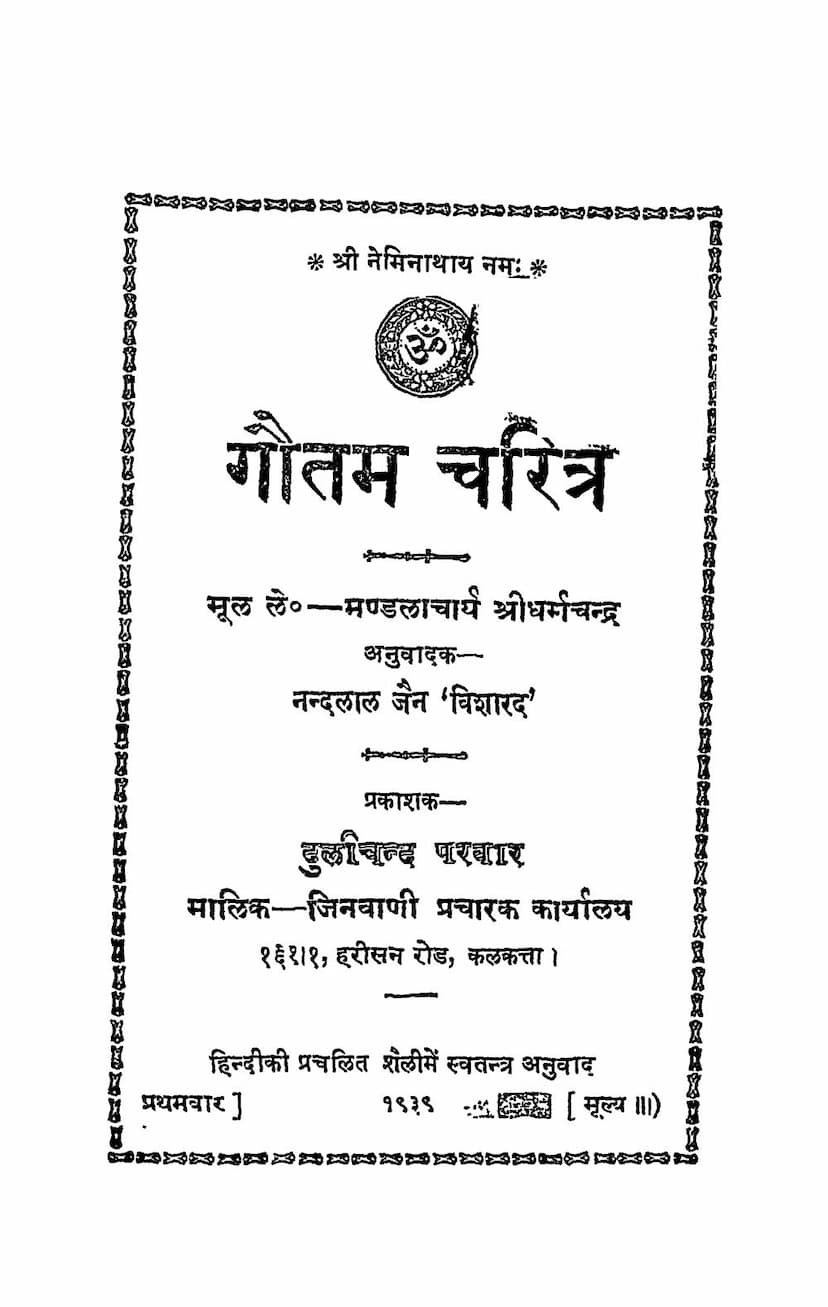Gautam Charitra
Added to library: September 1, 2025

Summary
This document is a Hindi translation of the "Gautam Charitra," a Jain text authored by Mandalacharya Shri Dharmchandra and published by Jinvani Pracharak Karyalaya in Calcutta in 1939. The book chronicles the life and teachings of Gautam Swami, a prominent disciple of Lord Mahavir.
Key aspects covered in the summary:
-
Introduction and Publisher's Note: The text emphasizes the importance of Puranas and biographies in Jain literature for conveying religious and philosophical truths to the common people, as philosophical texts can be difficult to understand. It highlights the need for Hindi translations of ancient Sanskrit and Prakrit texts to make them accessible to a wider audience. The publisher expresses hope that the book will benefit the Jain community.
-
Praise and Invocation: The book begins with invocations and praises to various Jain Tirthankaras and spiritual figures, including Lord Neminath, Arhants, Siddhas, Lord Mahavir, and Gautam Swami. It also invokes the Saraswati Devi for inspiration and the blessings of virtuous monks.
-
Description of Magadha and Rajgir: The text describes the prosperous and religiously vibrant region of Magadha, with a focus on its capital, Rajgir. It paints a picture of a flourishing land with abundant natural resources, happy people, and prominent Jain temples. King Shrenik and his virtuous queen Chellana are introduced as the rulers of this kingdom.
-
Lord Mahavir's Arrival and Shrenik's Devotion: The narrative then shifts to the arrival of Lord Mahavir Swami in Vipulachal mountain, where he delivers a sermon. King Shrenik, upon learning of the Lord's presence, organizes a city-wide procession to visit him. He expresses deep devotion to Lord Mahavir through prayers and admiration.
-
Gautam Swami's Inquiry: During the sermon, King Shrenik inquires about the past lives and spiritual journey of Gautam Swami, seeking to understand his wisdom and accomplishments.
-
Lord Mahavir's Teachings (First Chapter): Lord Mahavir expounds on the core principles of Jainism, differentiating between the paths of monks and lay followers. He elaborates on the three jewels of Jainism: Samyakdarshan (right faith), Samyakgyan (right knowledge), and Samyakcharitra (right conduct). He details the various types and merits of these principles, including the eight virtues of Samyakdarshan, the eighteen flaws to be avoided, and the seven cardinal sins. He also outlines the importance of observing vows, ethical conduct, and charitable deeds.
-
The Story of the Three Sudra Daughters (Second Chapter): This chapter delves into a past life narrative that explains the present circumstances of three unfortunate Sudra daughters. Their story, recounted by Muni Angabhushan, involves past karmic actions leading to their current state. It highlights the consequences of both virtuous and sinful deeds, emphasizing the impact of past lives on present circumstances. This narrative serves as a moral lesson on the law of karma.
-
The Story of King Vishwachan and Rani Vishalakshi: The text details the life of King Vishwachan and his beautiful queen Vishalakshi, their conjugal bliss, and the queen's subsequent renunciation of royal life due to dissatisfaction and a desire for freedom. Her act of deception and subsequent suffering, leading to a difficult rebirth, is presented. This story also serves as a karmic illustration.
-
Gautam Swami's Past Lives and Enlightenment (Third & Fourth Chapters): These chapters trace Gautam Swami's various rebirths and his journey towards spiritual enlightenment. The narrative includes his birth as a Brahmin named Gautam, his intellectual pride, and his eventual humbling and acceptance of Jain teachings through a divine encounter. The meticulous explanation of the Jain cosmological and ethical framework, including the classifications of beings, the nature of karma, and the paths to liberation, is a significant part of this section. The lineage of Tirthankaras, Chakravartis, and other significant figures is also detailed.
-
The Doctrine of Seven Tattvas and Principles of Jainism (Fifth Chapter): This extensive chapter delves into the fundamental Jain doctrines. It explains the seven tattvas (soul, non-soul, influx of karma, bondage of karma, cessation of karma, stages of spiritual progress, and liberation). It details the various classifications of souls, their lifespans, rebirths, and the intricacies of karma, its influx, bondage, and cessation. The concepts of Samvara (cessation of karma) and Nirjara (shedding of karma) are explained as crucial for achieving liberation. The chapter also discusses the structure of the Jain universe, the different types of heavens and hells, and the lifespans and attributes of celestial beings. The importance of devotion, righteous conduct, and the renunciation of worldly desires are reiterated.
-
Concluding Remarks: The text concludes by reiterating the significance of Gautam Swami's teachings and his role as the chief Ganadhar of Lord Mahavir. It emphasizes the benefits of following the Jain path for achieving spiritual liberation and the enduring relevance of these teachings. The book concludes with the author's dedication and blessings.
Overall, "Gautam Charitra" is a didactic text aiming to educate Jain followers on their religious tenets, ethical principles, and the karmic consequences of actions, all through the exemplary life and teachings of Gautam Swami.